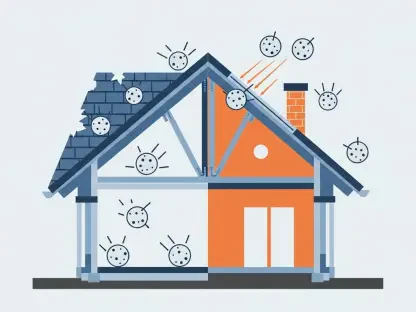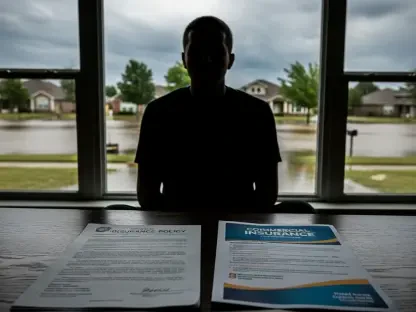The commercial property insurance market is undergoing significant transformation. Increasing natural disasters, stringent regulatory measures, and a challenging insurance environment are compelling property owners to rethink their strategies. This article explores how commercial property owners can adapt to these changing dynamics and secure effective risk management.
Understanding the Challenges
The Escalation of Natural Disasters
Recent years have seen a marked increase in the frequency and intensity of natural disasters like hurricanes, wildfires, tornadoes, and floods. These events have particularly impacted high-risk areas, making it challenging for property owners to secure comprehensive insurance coverage. High-risk regions are experiencing substantial financial strain, as insurers raise premiums or withdraw entirely from the market. The unpredictability and severity of these disasters force owners to continuously adapt, often at significant costs. Weather models predicting higher instances of extreme weather events further complicate the landscape, making risk planning an evolving challenge.
Property owners in affected regions find themselves in a precarious position as standard insurance policies become insufficient. Traditional coverage might not fully support the vast array of potential damages, pushing owners towards more heavily customized and often more expensive insurance products. Additionally, the ever-growing list of exclusions in these policies means that even with insurance, property owners might still face sizable out-of-pocket expenses in the aftermath of a disaster. This evolving scenario necessitates new and creative approaches to risk management and insurance procurement.
Regulatory Shifts and Financial Implications
In response to catastrophic incidents such as the 2021 Champlain Towers South collapse in Florida, governments have introduced stricter regulatory measures. These mandates include more frequent building inspections, often within a 30-year period, which has imposed significant financial burdens on property owners. New standards require comprehensive checks for structural integrity and resilience, highlighting deficiencies that might not have been previously identified and necessitating costly renovations or upgrades to comply.
The financial implications of these regulatory changes extend beyond the immediate costs of compliance. Property owners must budget not only for the initial expenses related to enhanced inspections and necessary repairs but also for ongoing maintenance to prevent future issues. This shift in regulations has prompted a reevaluation of budget allocations and financial planning, especially for smaller property owners who may struggle to meet these new demands. The cost of non-compliance, such as fines or increased vulnerability to disasters, further emphasizes the need for rigorous adherence to these regulations.
Navigating the Insurance Crisis
Insurers’ Withdrawal and Policy Limitations
Many insurance companies are pulling out of high-risk markets or offering policies with stringent limitations and exclusions. As a result, property owners find themselves struggling to obtain adequate coverage, prompting a need for alternative strategies. Insurers are increasingly cautious, factoring in the heightened risk profile of certain regions, which directly impacts their willingness to provide comprehensive coverage. This withdrawal leaves property owners vulnerable to uninsured losses, especially in areas where disaster likelihood is high and alternative options are limited.
Property owners must now navigate these restrictive and evolving policy terms, which often include higher deductibles, lower coverage limits, and coverage exclusions for specific types of damage. This environment forces owners to make challenging decisions about balancing cost versus coverage, ensuring that key risks are insured while managing financial constraints. The shrinking pool of insurers willing to participate in high-risk markets urges property owners to seek out innovative solutions and partners who understand the complexities of their circumstances and can provide tailored support.
Exploring Alternative Coverage Models
Given the growing difficulties in procuring insurance, property owners might need to look for solutions beyond traditional methods. This could involve turning to foreign insurers more willing to accept high-risk properties or adopting hybrid models that combine traditional insurance with self-insurance. Foreign insurers stepping into these markets may offer different perspectives on risk, often with more flexible terms that cater better to the unique needs of properties in high-risk areas. These insurers might incorporate advanced risk assessment techniques and mitigation incentives, which can be more suitable and advantageous for high-risk properties.
Hybrid insurance models, combining conventional insurance with elements of self-insurance, are becoming increasingly appealing. Property owners take on a portion of the risk themselves, often leading to lower premiums while maintaining some level of coverage for catastrophic events. This approach encourages a deeper investment in risk mitigation, as reduced claims directly benefit the owner’s bottom line. By exploring these alternative coverage models, property owners can create a more resilient and cost-effective insurance strategy that aligns with their specific risk profiles and financial capabilities.
Proactive Property Management
Investing in Mitigation Technologies
To enhance property insurability, owners are encouraged to invest in advanced infrastructure and ongoing maintenance. Technologies such as elastomeric roof coatings and hurricane-resistant installations not only reduce the likelihood of damage but also make properties more attractive to insurers. These mitigation measures demonstrate commitment to risk reduction and can often result in lower insurance premiums or improved coverage terms. Tools like impact-resistant windows, stormproof roofing materials, and superior drainage systems are vital in showcasing proactive risk management to insurance companies.
The investment in these technologies is strategic, aimed at fortifying properties against prevalent threats and reducing the potential for significant damage. Detailed assessments of property vulnerabilities followed by targeted upgrades play a crucial role in this strategy. Insurers see these investments as a sign of diligent property management, often rewarding owners with better terms. This proactive approach not only enhances insurance outcomes but also ensures long-term asset protection, making it a critical part of modern property management.
Leveraging Predictive Technologies
Emerging technologies, including leak detection systems and flood risk monitors, play a critical role in preventing damage and improving a property’s appeal to insurance companies. These tools offer predictive insights that can significantly mitigate risks. Predictive analytics enable property owners to foresee and address potential issues before they escalate into significant problems. For instance, smart sensors can detect minute water leaks, allowing immediate repairs and preventing extensive water damage and mold growth, which could otherwise lead to substantial insurance claims.
The implementation of these predictive technologies requires initial capital outlay but offers significant long-term benefits. Real-time data and alerts ensure that property managers can maintain optimal conditions, minimizing damage and facilitating quicker response times to emerging threats. As insurers increasingly value data-driven risk management, properties leveraging advanced technologies gain a competitive advantage. By predicting and preemptively addressing potential damage, these technologies enhance a property’s resilience and insurability, ultimately contributing to lower insurance costs and better coverage options.
Collaborative Risk Management
Working with Multiple Insurance Brokers
Engaging multiple insurance brokers and agencies broadens the range of available options for property owners. No single agency can cover every possible risk, so a collaborative approach increases the likelihood of securing suitable coverage. By consulting multiple brokers, property owners can compare different offers, ensuring they receive the most comprehensive and cost-effective policies available. This strategy not only increases the chances of finding acceptable insurance terms but also enables owners to leverage the unique strengths and specializations of various brokers.
Brokers often have distinct approaches to risk assessment and connections with different underwriters, so diversifying broker partnerships can yield a more nuanced and robust insurance strategy. Additionally, engaging with multiple brokers allows property owners to stay informed about the latest industry trends and innovations, which can influence their decision-making processes. This broad-based approach ensures that property owners can build resilient and adaptable insurance portfolios tailored to their unique risk profiles and management needs.
Forming Expert Teams
Given the complexity of modern insurance policies, particularly in disaster-prone areas, property owners should surround themselves with experts in insurance and risk management. These professionals can provide the detailed understanding necessary to navigate the evolving insurance landscape effectively. Expert teams can evaluate existing policies, identifying potential gaps and recommending tailored coverage solutions that align with the specific risks and needs of the property. Their in-depth knowledge ensures that property owners are neither over-insured nor under-insured, optimizing the balance between cost and protection.
Insurance and risk management experts also stay abreast of regulatory changes and industry advancements, offering insights that can further inform property management strategies. Their expertise is invaluable in negotiations with insurers, helping secure the best possible terms and coverage. Collaborating with these experts creates a strategic advantage for property owners, ensuring comprehensive risk management and robust insurance positioning. As the regulatory landscape and insurance market continue to evolve, having a team of skilled professionals becomes an indispensable asset for property owners.
Open to Future Adaptations
The market for commercial property insurance is experiencing considerable change. Factors such as rising occurrences of natural disasters, tighter regulations, and a tough insurance landscape are driving property owners to reevaluate their approaches. This article delves into the ways commercial property owners can adjust to these evolving circumstances and implement effective risk management strategies.
Today’s commercial property insurance market is facing an unprecedented wave of transformation. Property owners now encounter more frequent and severe natural disasters, coupled with increasingly strict regulatory requirements. This tough environment forces them to reshape their insurance strategies. Understanding how to navigate these shifts is crucial for developing robust risk management plans. This analysis provides insights into the innovative measures commercial property owners can adopt to stay resilient in a fluctuating market and protect their investments from unexpected challenges.









